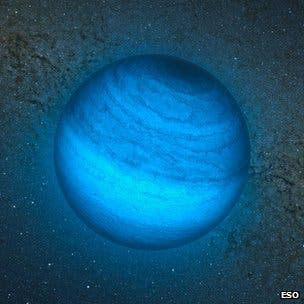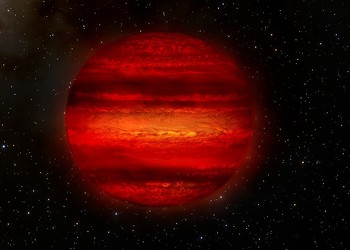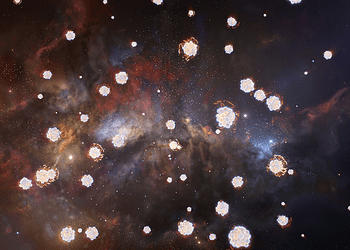Like in a scene from a Sci-fi novel, about 100 light years away, somewhere in the constellation Doradus, a planet is travelling around the galaxy by itself, without orbiting a parent star. This “rogue planet“, has a temperature of about 400C and a mass between 4 to 7 times that of Jupiter – close to the mass limit beyond which it would have become a brown dwarf.
The object, that so far has the captivating name of CFBDSIR2149, has been discovered while observing a region of space occupied by a group of about 30 stars called the AB Doradus Moving Group – a group of stars that have formed at the same time – most likely from the same initial gaseous nebulae. This fact was derived from the similarities in the composition, age and the similar direction of movement through space of the stars – which place the age of this group somewhere between 50 and 120 million years old – a reasonably young star group.

The initial observations placed the object in the category of brown dwarfs – a class of sub-stellar objects – that are more massive then the biggest planets – the gas giants, yet they don’t have enough mass to start nuclear fusion. However, further analyses revealed that our object was in fact smaller than this – making it a planet – a gas giant. The whole detection was possible due to the fact that our “rogue” emits light in the infrared wavelengths.
Astronomers said that based on its estimated age, through computer models of planetary evolution, they were able to make further deductions regarding the planet’s mass – 4 to 7 times the mass of Jupiter, and surface temperature of 400 degrees Celsius (750 degrees Fahrenheit).
The planet was discovered during a survey using the infrared cameras of the Canada-France-Hawaii Telescope on Hawaii’s Mauna Kea and the Very Large Telescope (VLT) in Chile, as study co-author Etienne Artigau of the University of Montreal said: “This object was discovered during a scan that covered the equivalent of 1,000 times the [area] of the full moon.”
Of course, this is not the first time such a “nomad planet” has been spotted, but this observation is special because it found the closest such object discovered so far – only 100 light years away, the first such planet that is relatively close to our solar system, as study co-author Etienne Artigau put it: “We observed hundreds of millions of stars and planets, but we only found one homeless planet in our neighbourhood“.
A big question in the case of all such rogue planets is how this planet came to be? Maybe it formed inside a solar system, just as any other planet, and got ejected afterwards – through gravitational interaction perhaps with a more massive object entering that system. Or it formed separate from any solar system from the beginning, similar to the formation of a star – through progressive accretion of the gas of a dense nebulae. This question remains open – and perhaps will remain for some time to come.
Philippe Delorme of France’s Institute of Planetology and Astrophysics said: “these objects are important, as they can either help us understand more about how planets may be ejected from planetary systems, or how very light objects can arise from the star formation process.”
The findings were reported in the journal Solar and Stellar Astrophysics.
source: BBC






